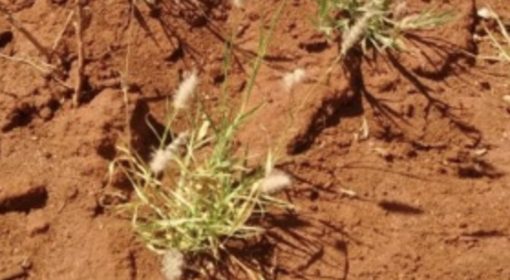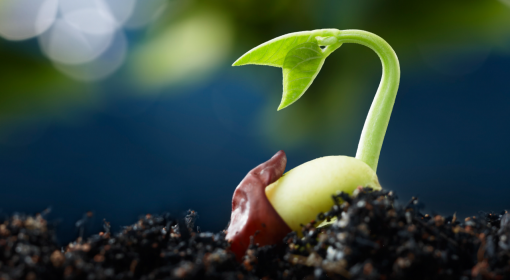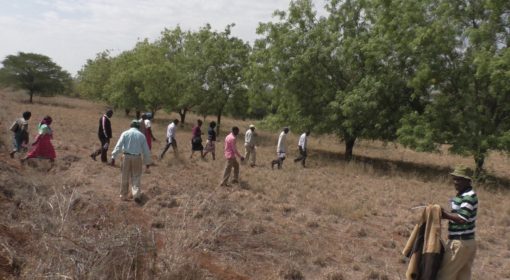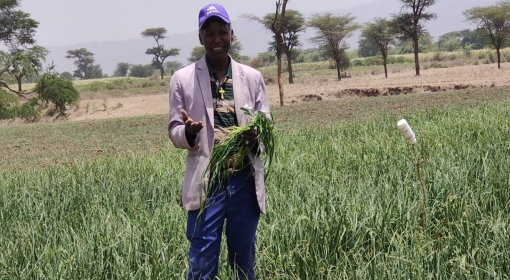Authors: Luwieke Bosma (MetaMeta), Ashutosh Mishra (PRADAN) and Ishan Agarwal (FES).
In the blog on livestock production in India we read about the importance of the livestock sector in India and its characteristics. One significant aspect that came out is that of the total cultivated land, only 4-5% of arable land is used for fodder production. While out of the total landmass in India, 69% is dryland. In this blog we therefore will share with you an example from indigenous pasture production in Kenya, where 80% of the country is classified as dryland, to see where we can meet each other and take things across borders.

One important factor related to livestock production is feed production. According to Yadav et al. (2017) the large share of feed requirement is being met from crop residues. It revealed that the fodder requirement in India is “883.95 Mt of green fodder and 583.66 Mt of dry fodder whereas the estimated fodder production is 664.73 Mt of green fodder and 355.93 Mt of dry fodder.” Meaning an additional 219Mt of green fodder and 226.53 Mt of dry fodder is required. However, there is debate on this premise that livestock production heavily depends on crop residues in India. Most of livestock production in India is from states which have large lands under commons. India became largest dairy producers and net exporters and recently, third largest meat exporters in just 3 years when government opened exports. The paper by Yadav is highly technical and not fully addressing the social-ecological realities of the country. [1]
Though the situation is more nuanced, there are large deficiencies in the livestock sector for quality feed. There are multiple factors that could contribute to this situation. One factor could be the low availability of quality seed in fodder crops. Quality seed production is an important area to strengthen to stimulate fodder and pasture production, and the larger silvopasture sector. Currently a large area is sown using poor quality uncertified seed that gives poor fodder yield. And farmers usually do not produce these seeds. [2]
Another factor could be the expansion of semi-arid areas in India, to about 34% of the country’s total area. “An increasing trend in aridity was observed in central India, including Rajasthan and Madhya Pradesh, among others. The eastern boundaries of the semi-arid region in north India have expanded in recent decades, converting the dry sub-humid regions into semi-arid regions.” Researchers stressed that climate change, especially changing rainfall patterns and increased temperatures, could cause changes in aridity. Along with extensive land use practices, this can cause land degradation, leading to further desiccation of the land. [3]
One of the other reasons for this, especially in the tribal belts of Santhal Pargana could be non-usage of the bigger livestock for milk. Traditionally, the Santhal tribes have been avoiding milking of animals. Occasionally, for the sick or for the children, a pint or two is taken out. Otherwise, the cattle are left without milking. Thus, a no short-term profit withdraws the community’s empathy towards quality feed. Subsequently, growing quality feed on the private land would also be input and labor intensive. Some other major factors for reducing fodder or crop residues for livestock are:
- Commons and other grazing resources that are the major source of fodder for livestock in India are fast diminishing. More than 70% of its meat and more than 50% of its milk is produced on common property resources in traditional Systems‘[1].
- Grazing restrictions in forests
- Drastic shift from food crop cultivation to cash crop cultivation – this resulted in dramatic reduction of crop residues. One example is reduction in cultivation of dual-purpose crops (which provide food and fodder) such as millets and sorghum.
- High labor crops also prevent crop farmers from harvesting crop residues & selling them – also a loss of a good income source. Farm mechanization also prevents proper extraction of crop residues.
- Fodder deficit is being caused more by mismanagement
- Lack of regional coordination between areas that produce large amounts of crop residues to other fodder deficit regions – eg. Huge amounts of paddy straw or maize crop residue is produced in several parts of India . but this is not harvested or sold to farmers – it is in fact burnt down by farmers due to high labor costs.
- In 2021, India exported 28 lakh tons of maize and 18 lakh tons of oil meal cakes, two of the largest requirements for intensive livestock keeping. Further the production of food grains in the country is estimated at a record 338.31 million tonnes which is higher by 3.77 million tonnes than the production of food grain during 2020-21. And the production during 2021-22 is higher by 23.80 million tonnes than the previous five years’ average production of food grains
Relating our experience in Kenya on fodder production with road water harvesting in African drylands.
Now we take a side-step and move to Kenya. In Kenya and larger East-Africa, drylands provide a vital livelihood stream to people across the globe through a range of goods, products and ecosystem services. These arid and semi-arid lands (ASALs) are characteristically very fragile and are facing increased land use and land use change pressure compounded by high climate variability. Land degradation, reflected not only by the reduced capacity of the land to sustainably produce ecosystem services but also its economic value, is widely recognized as one of the most serious global challenges of our time. It directly affects over 250 million people and puts some one billion people, mainly pastoralists, at risk (Wessels et al. 2007). MetaMeta with partners conducted a project from 2017-2020 with 2 main objectives 1) restoration of degraded drylands with indigenous grass species and road water harvesting, and 2) improve livestock productivity through improved quantity and quality of feed.

Vegetation degradation in the dryland environments is a worldwide phenomenon and is recognized as an important measure of degradation over different spatial and temporal scales (Visser et al. 2007). Changes in the composition of the herbaceous vegetation cover, grasses and herbs, exemplify the short-term indicators of vegetation degradation which are reversible (Mganga et al. 2018). However, a shift in state from herbaceous to bushy dominated vegetation types is indicative of more permanent degradation (Bennett et al. 2012). Natural vegetation change from ‘excellent condition’ to ‘poor condition’ in the dryland environments triggers a subsequent but comparative increase in the dominance of unpalatable plant species over the more preferred palatable plant species (Angassa 2014; Kassahun et al. 2008). Grass reseeding has been used successfully as a means of restoring degraded drylands in Africa (Nyangito et al. 2009; Mganga et al. 2010; 2015; Opiyo et al. 2011). As a rule of thumb, the best grasses for any reseeding program are those that are native and found on range sites similar to those to be reseeded. Some of the common indigenous grasses commonly used for reseeding programs in Kenya are African foxtail grass (Cenchrus ciliaris), Bush rye grass (Enteropogon macrostachyus) and Maasai Love grass (Eragrostis superba – see photo). (read more here).

The main results showed that Chloris gayana cv Boma and E. superba produced significantly higher dry matter biomass yields and attained higher seed production than other species. High biomass and seed production indicate their suitability to support livestock production and replenish depleted soil seed banks, respectively.
Enteropogon macrostachyus and C. ciliaris displayed significantly higher values for components of establishment and ecological restoration success, that is, plant densities, tiller densities and basal cover. Overall, C. roxburghiana ranked lowest in the measured morphoecological characteristics.


Successful restoration of degraded African semi-arid rangelands using indigenous grass reseeding can best be achieved through careful selection of grasses to take advantage of their specific morphological characteristics. This selection should primarily be informed by the intended use of the rangeland and the specific challenges of restoring each site.
Reseeding programs aim at improving existing ground cover and pasture biomass to an extent or in a manner not possible by grazing management. This can be accomplished by over-sowing into existing vegetation with a superior species, reseeding a denuded land and establishing a completely new pasture, with or without the aid of irrigation. Flood based irrigation and road water harvesting are two viable and low-entry methods to boost fodder production in drylands.
Systematically introducing the spreading of short-term floods from ephemeral rivers and from road drainage combined with water retention in trenches will lead to increase of soil moisture levels, as water is allowed time to infiltrate slowly, this water will move in both vertical and lateral directions (depending on soil characteristics). This can revitalize drylands into a highly productive production system – in terms of return to labor. Growing fodder with flood and road drainage water has several advantages: (1) it turns a threat (flood/drainage water) into an asset; (2) it relieves the pressure on the dry rangelands and creates an economically rewarding production system, and (3) it requires almost no land preparation and hence it can also be applied in areas that are short in skills and labour. [4]
Now, before we move back to India there are two important notes. First, it is important to note that the sub-humid climate in AEZ 7 is different from dryland agriculture, thus some ground issues may be different, and the solutions must be aligned with the sub-humid conditions. Second, the conditions of formal tenure for communities over community lands in Kenya is different from India, this would change the role of communities and community institutions.
What lessons can we take from Kenya? The interventions of growing fodder with flood and road drainage water in Kenya was taken up by champion farmers who spread the idea to their communities. Moreover, the County Government of Kitui has taken up the approach in their policies which enabled wide-scale uptake and promotion of fodder production in their jurisdiction. Furthermore, the project team consisted of University, Private organisation, Community/champion farmers and the regional government. This enabled co-creation of knowledge and immediate fine-tuning to needs and requirements of each partner involved. Fine-tuning of such an approach to the specific social-ecological context in India’s states of Jharkhand and Madhya Pradesh, coupled with a focus on indigenous fodder species and management of commons with low-cost water harvesting interventions, is needed to explore its potential for India.

What lessons can we take to Madhya Pradesh and Jharkhand in India?
The states of Jharkhand and (eastern parts of) Madhya Pradesh receive an average rainfall of 1200-1400 mm annually, however, they suffer from droughts and water stress during non-rainy months (NITI Aayog, 2015). Undulating terrain, high rainfall and depletion of forests resulted in large scale land degradation in both the States. The agro-climatic zone 7, in which both states fall, is hardest hit on several scores: around 35% of the land area is degraded and 41% households living below the poverty line; the highest amongst all the zones.
In India, the common lands constitute 25% of the total geographic area with almost half of this being divided between community pasture and grazing lands, village forests and woodlots. Whereas more than half of the annual fodder requirement is met from the cultivated fodder and crop residues, the balance is from open grazing and fodder availability from common lands. Sustainable intensification of livestock production systems might become a key climate mitigation technology. It can provide quality green biomass at low cost and high yield. Intensive cultivation of fodder trees is also a key method to get green biomass throughout the year and increase livestock productivity.
This leads us to the question: How can we better utilize the commons for quality fodder and pasture production, creating a win-win scenario to protect these lands from degradation? We do not have answers yet, but we like to share a few pointers to further dive into:
- Explore how extensive indigenous pasture production coupled with low-cost water harvesting can support agro-pastoralist farming systems.
- Investigate indigenous grass species and other types of fodder. Rank them on key criteria, e.g. drought tolerance, biomass, plant density, seed production, nutrition, etc.
- Focus on low-cost, small-scale and widespread water harvesting methods, integrate capturing runoff from roads, and link this specifically to regenerate low-productive common lands, so they can be revitalized into fodder-baskets.
- Explore options for specialization in the following production streams: quality hay & silage, and indigenous grass seeds. This can support existing systems of beef and dairy production.
- Influencing policy on institutional level to develop fodder management policy with dedicated agency to steer management of grazing lands and fodder resources in India.
- Increasing awareness among the community members and its subsidiaries like PRI (Panchayati Raj Institution) regarding the ownership of commons and its utilization as a key natural resource.
- Increase understanding of cultural aspects around livestock keeping.
- Explore linkages between increasing productivity of livestock systems to crop farming through manure provision.
These are some ideas we think are worth deeper investigation. We wish to extend an invitation to everyone with interest in fodder production systems to reach out to us so we can explore the opportunities for Jharkhand and Madhya Pradesh.
Please reach out to: Luwieke Bosma (Lbosma@metameta.nl)
References:
[1] Yadav ME, Jagadeeswary V, Satyanarayan K, Kiran M and Mohankumar S 2017. Fodder resource management in India-A critical analysis. International Journal of Livestock Research 7 (7): 14-22
[2] https://www.pashudhanpraharee.com/problems-in-fodder-seed-production-in-india/
[3] timesofindia.com
[4] Mganga, K. Z., Kaindi, E., Ndathi, A. J. N., Bosma, L., Kioko, T., Kadenyi, N., Wambua, S. M., van Steenbergen, F., Musimba, N. K. R. (2021). Morphoecological characteristics of grasses used to restore degraded semi-arid African rangelands. Ecol Solut Evidence, 2, e12078. https://doi.org/10.1002/2688-8319.12078



